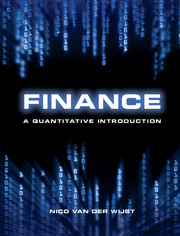Book contents
- Frontmatter
- Contents
- List of Figures
- List of Tables
- Acronyms
- Preface
- 1 Introduction
- 2 Fundamental concepts and techniques
- 3 Modern portfolio theory
- 4 Market efficiency
- Chapter 5 Capital structure and dividends
- 6 Valuing levered projects
- 7 Option pricing in discrete time
- 8 Option pricing in continuous time
- 9 Real options analysis
- 10 Selected option applications
- 11 Hedging
- 12 Agency problems and governance
- Solutions to exercises
- Glossary
- References
- Index
Chapter 5 - Capital structure and dividends
Published online by Cambridge University Press: 05 February 2013
- Frontmatter
- Contents
- List of Figures
- List of Tables
- Acronyms
- Preface
- 1 Introduction
- 2 Fundamental concepts and techniques
- 3 Modern portfolio theory
- 4 Market efficiency
- Chapter 5 Capital structure and dividends
- 6 Valuing levered projects
- 7 Option pricing in discrete time
- 8 Option pricing in continuous time
- 9 Real options analysis
- 10 Selected option applications
- 11 Hedging
- 12 Agency problems and governance
- Solutions to exercises
- Glossary
- References
- Index
Summary
The combination of capital categories that a firm uses to finance its operations is called its capital structure. It is expressed in ratios such as debt-to-equity or debt-to-total assets. Dividends are the payments that stockholders receive as return on their capital. An old issue in finance is whether the choice of dividend policy or capital structure can create value for investors. The traditional opinion was that dividends and capital structure decisions could increase firm value, even under idealized conditions. In their groundbreaking analyses, Modigliani and Miller [1958, 1961] conclude that both are irrelevant in perfect capital markets. The value of a firm is not affected by how it is divided over capital categories and the value of a share is unaffected by whether its income is in the form of dividends or capital gains. Their conclusions, often ridiculed at the time, are now generally accepted as a correct analysis, not an accurate description of the actual situation. Both were later awarded the Nobel prize in economics. We shall review their arguments and some later extensions. We begin, however, with a description of the categories that constitute capital structure.
Dimensions of securities
Securities are financial contracts that can be framed in infinitely many ways by varying the basic elements (or dimensions). In our analyses we concentrate on the general principles, so we only include the basic types of securities, such as common stock, ordinary debt and ‘plain vanilla’ options. This section sketches some of the wider variety of securities that exist today.
- Type
- Chapter
- Information
- FinanceA Quantitative Introduction, pp. 136 - 164Publisher: Cambridge University PressPrint publication year: 2013



